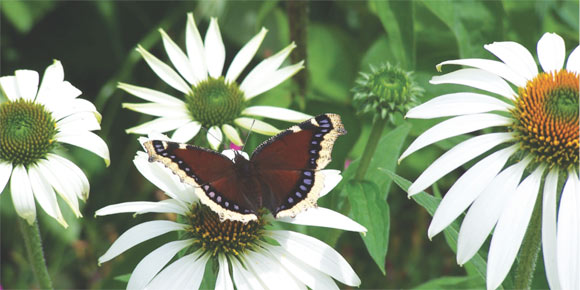“Yuck! There’s a caterpillar on my parsley!” Squish!
That’s the usual response to creepy crawlies on plants, but when we learn that the green and black caterpillar with the yellow-orange spots sharing our parsley or carrot tops will become a beautiful black and blue swallowtail butterfly, it is easier to resist the urge to bring down the hand of God.
The young larvae of Papilio polyxenes look like bits of bird poop on the parsley leaves which they eat voraciously, soon turning into more recognizable black and white forms and then into the pretty caterpillars themselves. They can eat a stand of parsley down to the stems, but the parsley will soon recover, so I let them enjoy their meal.
The larvae of the red admiral butterfly (Vanessa atalanta) is not half as attractive. The caterpillar is blackish and spiny with maybe just a touch of orange or yellow on its sides. It hides out on stinging nettles in a tent it makes from the leaves of its intended food. As a butterfly, though, it is a welcome visitor to the garden, with its red to orange bands on a black field with white markings at the wing tips. This is an aggressive butterfly that will defend its territory vigorously once it sets up house.
The Mourning Cloak Butterfly
Another outstanding visitor is the mourning cloak butterfly (Nymphalis antiopa). This is a fairly large butterfly with purple-black or brown-black wings featuring a bright yellow or white border and a row of iridescent blue spots at the border’s inner edge.
The mourning cloak’s common name comes form its resemblance to the kind of coats at one time worn by people in mourning, but in England, it is more aptly called Camberwell Beauty.
The larvae are spiny and unattractive, and they feed on willows, American elm, cottonwoods and paper birch, laying their eggs in a band around the twigs of these trees. The butterflies like to feed on the sweet sap of the oak tree or on decaying fruit, but occasionally they will come to a flower for nectar.
The Fritillary
An even more common butterfly is the pretty little orange and brown fritillary. Its larvae feed on pansies and violets. The caterpillar is attractive with orange, and black stripes interrupted with spots of white and black spines. It will voraciously devour pansy blossoms and foliage in your garden.
While all these butterflies favour certain plants on which to give their larvae the best start, the butterflies themselves will feed on a diverse group of plants. They favour native species, particularly composite flowers such as those from the daisy and sunflower families, but also liatris, from the carrot family including Queen Anne’s lace and parsley, grasses, Joe Pye weed, gaillardia and yarrow to name a few.
Wondering how to tell a butterfly from a moth? A butterfly stands with its wings upright, while a moth stands with its wings tucked down around its body.
Dorothy Dobbie is the publisher of Manitoba Gardener magazine. Subscriptions are available at 204 940 2700 or at localgardener.net.



